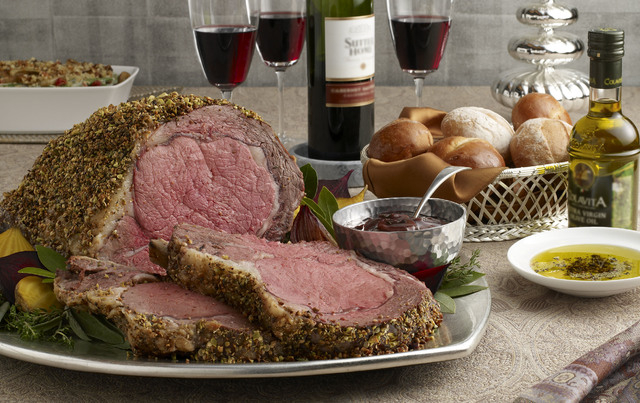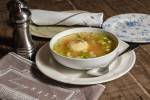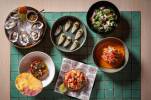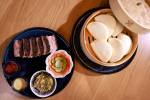Holiday feast: No one way to best prepare the roast
“They would feast on Who-pudding, and rare Who-roast beast.”
In fine Seussian tradition, the origins of the Whos’ Who-roast beast remain a mystery, and sometimes such things are for the best. For all of us who aren’t of the Who persuasion, however, the Christmas beast tends to be defined by tradition.
Sam Marvin, chef/owner of Echo &Rig Butcher and Steakhouse at Tivoli Village, said the quintessential Christmas meat entree is different in various parts of the country.
“It’s definitely culture-based,” Marvin said.
In Las Vegas, that usually means either a standing rib roast — the source of prime rib — or New York roast or ham.
“Prime rib is No. 1,” said Tim Jensen, owner of Village Meat &Wine. “It’s a tradition. I probably sell more of that at Christmas than I do all year.”
“Prime rib is just the biggest thing for Christmas,” agreed Ron Lutz, owner of The Butcher Block.
Marsha Gilford, vice president of public affairs for Smith’s Food &Drug, said hams of various kinds are the top seller among the chain’s Christmas shoppers. In second place: the aforementioned New York roast.
And, Marvin said, it’s because of tradition.
“If you notice, on most of our holidays, the food is very old-fashioned,” he said. “The oldest traditional food goes back to the old Sunday dinner in England. I think that’s why we see it.”
Marvin added that a centerpiece roast is a way to treat ourselves for the holiday — “You don’t eat that every day of the year” — and Sean Griffin, executive chef of Prime at Bellagio, agreed.
“When you think about the holidays,” Griffin said, “you want to surround yourself with the important people in your life — close friends, family, you get the family reunion going on. You go all out. You’re impressing. You want to do the best for those who are the closest to you.”
But he hinted that there may be a more primal, gather-around-the-campfire thing going on, too.
“There’s something really special about cooking something big,” Griffin said. “So you can put it in the center of the table. You’ve got Dad or you’ve got somebody who goes over there and carves it up and feeds it to the family. It’s part of the whole entertainment thing of the holidays, too.”
The chefs won’t be featuring prime rib — a Las Vegas buffet standard — on Christmas, but they’ll be going big. Prime will feature a bone-in filet with cauliflower gratin topped with shaved truffles, and a Maine lobster salad, or a Wagyu Tomahawk steak if a couple really wants to share. Echo &Rig will expand on the traditional theme with crown roast of lamb, goose with stuffing and beef Wellington. But at Echo &Rig’s butcher shop, Marvin said, the prime rib/standing rib roast remains the most popular.
Jensen said in addition to other factors, that’s because of how it tastes.
“The prime rib is close to the chuck, so it carries more marbling,” he said. “That’s where the flavor is.” Pay more for Prime — which would make it Prime prime rib — and you’ll get even more marbling, ergo more flavor. Only 2 percent of domestic beef is graded Prime, Jensen said.
“You feed a lot of people, too,” Lutz said. He said a four-rib roast, about 8 to 10 pounds, will feed about eight people. Lutz hadn’t priced his Prime roasts at press time but was offering Choice grade for $13.99 a pound. Jensen had Prime for $16 a pound and domestic Kobe for $18.
So, how best to roast it? There is — no surprise here — no single way.
“We recommend 400 (degrees) for the first 30 minutes, then turn it down to 300 for 20 minutes a pound,” Lutz said. “Pull it out when the center’s at 128 to 130 (degrees), let it rest about 20 minutes and then carve.”
Jensen said he sells a jus and a seasoning that he recommends. Beyond that, he said to place the roast fat side up in a roasting pan, cover and put it in the oven at 325 degrees, allowing 30 to 32 minutes per pound for rare, 34 to 37 minutes per pound for medium and 39 to 42 minutes per pound for well done. Remove it from the oven at 140 degrees for rare, 160 for medium or 170 for well done and let rest 15 minutes before carving.
And Christmas dinner — a very traditional Christmas dinner — will be on the table.
1 beef rib-eye roast, bone-in (2 to 4 ribs), small end, chine (back) bone removed (6 to 8 pounds)
Seasoning:
½ cup unsalted shelled pistachios, finely chopped
¼ cup coarsely crushed coriander seeds
2 tablespoons finely chopped fresh thyme
2 tablespoons extra virgin olive oil
1 teaspoon coarse grind black pepper
Holiday Wine Sauce:
2 tablespoons extra virgin olive oil
4 ounces cremini or button mushrooms, sliced
¼ cup finely chopped shallots
1 cup beef broth, divided
1 cup cabernet sauvignon
1 tablespoon cornstarch
1/8 teaspoon black pepper
1 teaspoon fresh thyme leaves
Heat oven to 350 degrees. Combine seasoning ingredients; press evenly onto all surfaces of roast.
Place roast, fat side up, in shallow roasting pan. Insert ovenproof meat thermometer so tip is centered in thickest part of beef, not resting in fat or touching bone. Do not add water or cover. Roast for 2¼ to 2½ hours for medium rare; 2½ to 3 hours for medium.
Remove roast when meat thermometer registers 135 degrees for medium rare, 145 degrees for medium. Transfer roast to carving board; tent loosely with aluminum foil. Let stand 15 to 20 minutes. (Temperature will continue to rise about 10 to 15 degrees to reach 145 degrees for medium rare; 160 degrees for medium.)
Meanwhile, prepare Holiday Wine Sauce. Heat olive oil in large nonstick skillet over medium heat until hot. Add mushrooms and shallots; cook and stir 6 to 9 minutes, or until mushrooms are tender and browned. Remove from skillet; keep warm. Add ¾ cup broth and wine to skillet; cook and stir over medium heat 12 to 16 minutes or until reduced to 1 cup. Combine remaining ¼ cup broth and cornstarch in small bowl. Whisk cornstarch mixture and pepper into wine mixture; bring to a boil. Cook 1 minute or until sauce thickens, stirring occasionally. Remove from heat; add thyme and mushroom mixture. Season with salt, as desired.
Carve roast into slices; season with salt, as desired. Serve with Holiday Wine Sauce.
Serves 8 to 10.
— Recipe from the Beef Checkoff
1 beef tenderloin roast, center-cut (about 2 to 3 pounds)
2 pounds cipollini onions, peeled
2 pounds small Brussels sprouts, trimmed
1 tablespoon olive oil
1¼ teaspoons salt, divided
2 tablespoons chopped fresh thyme
1 tablespoon pepper
Sauce:
1/3 cup balsamic vinegar
3 tablespoons finely chopped shallots
1 can (16 ounces) whole berry cranberry sauce
Heat oven to 425 degrees. Combine onions, Brussels sprouts, oil and 1 teaspoon salt on metal baking pan; toss to coat. Set aside.
Combine thyme and pepper; reserve 1 teaspoon thyme mixture for sauce. Press remaining thyme mixture evenly onto all surfaces of beef roast.
Place roast on rack in shallow roasting pan. Insert ovenproof meat thermometer so tip is centered in thickest part of beef. Do not add water or cover. Place vegetables in oven with roast. Roast beef 35 to 45 minutes for medium rare, 45 to 50 minutes for medium. Roast vegetables 45 to 50 minutes, or until tender and lightly browned.
Meanwhile, prepare sauce. Combine vinegar and shallots in small saucepan; bring to a boil. Reduce heat; simmer 3 minutes. Stir in cranberry sauce; bring to a boil. Reduce heat; simmer 6 minutes to blend flavors, stirring occasionally. Remove from heat; stir in reserved 1 teaspoon thyme mixture and remaining ¼ teaspoon salt. Keep warm.
Remove roast when meat thermometer registers 135 degrees for medium rare, 145 for medium. Transfer roast to carving board; tent loosely with aluminum foil. Let stand 15 to 20 minutes. (Temperature will continue to rise about 10 to 15 degrees to reach 145 for medium rare, 160 for medium.)
Carve roast into slices; season with salt, as desired. Serve with vegetables and sauce.
Serves 8 to 12.
— Recipe from the Beef Checkoff
For the goose:
1 12½-pound goose, neck reserved
1 tablespoon butter
3 shallots, sliced
1½ cups Madeira
4 small oranges, quartered
4 cups canned low-salt chicken broth
1 cup fresh orange juice
4 large shallots, sliced
1/3 cup plus 2 tablespoons Madeira
1 tablespoon cornstarch
2 tablespoons (about) honey
For the shallots:
1 tablespoon butter
18 shallots, peeled
1½ cups Madeira
¾ cup canned low-salt chicken broth
3 tablespoons honey
To make the goose, remove excess skin, fat and quills from goose. Carefully lower goose into large pot of boiling water. Boil 1 minute. Remove from water. Pat dry. Place on rack in large pan. Chill uncovered 2 days.
Melt butter in heavy large saucepan over medium heat. Add goose neck; cook until brown, turning once, about 5 minutes. Add shallots; saute until tender, about 4 minutes. Add 1½ cups Madeira and 1 orange. Boil until reduced by one-third, scraping up browned bits, about 3 minutes. Add broth and juice. Boil until reduced to 2 cups liquid, about 45 minutes. Strain sauce into saucepan. (Can be made 2 days ahead. Chill.)
Preheat oven to 325 degrees. Pierce goose skin (not meat) all over with fork. Place halved shallots and remaining 3 oranges in cavity of goose. Tie legs together to hold shape. Season with salt and pepper. Place goose, breast side down, on rack in roasting pan. Roast 1½ hours.
Transfer goose to platter. Pour off fat from pan. Place goose, breast side up, on rack in pan. Roast until thermometer inserted into thickest part of thigh registers 180 degrees, about 1 hour 15 minutes. Increase oven temperature to 450 degrees. Roast goose until golden, about 10 minutes. Transfer to platter.
Pour off all fat from pan, leaving browned bits in pan. Pour 1/3 cup Madeira into pan. Gently heat pan while scraping up browned bits. Pour mixture into sauce. Dissolve cornstarch in remaining 2 tablespoons Madeira. Whisk into sauce. Boil until thickened to sauce consistency, about 7 minutes. Stir in 2 tablespoons honey. Season to taste with more honey, salt and pepper.
To make the shallots: Melt butter in heavy large saucepan over medium heat. Add shallots; saute until golden, about 10 minutes. Stir in Madeira, broth and honey. Simmer until shallots are tender and liquid is reduced to glaze, about 1 hour 10 minutes. (Glazed shallots can be made 1 day ahead. Cover and refrigerate. Rewarm over low heat, stirring often, before serving.)
Carve goose. Arrange slices on plates. Top with Madeira-glazed shallots and sauce and serve.
Serves 6.
— Recipe from Bon Appetit
Contact reporter Heidi Knapp Rinella at hrinella@reviewjournal.com or 702-383-0474.




























